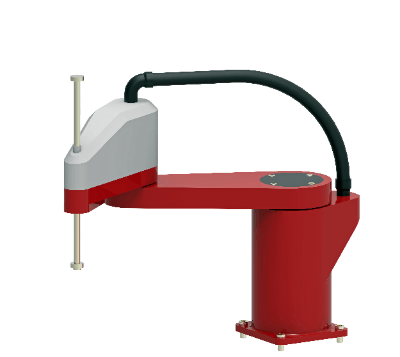What Is a SCARA Robot?

A SCARA robot is a horizontally articulated industrial robot with three rotational axes for horizontal motion and one axis for vertical motion.
The acronym SCARA stands for “Selective Compliance Assembly Robot Arm,” and the robots are commonly referred to as SCARA robots. SCARA robots have the following features.
- Quick horizontal movements
- Relatively inexpensive
- High mechanical rigidity in the vertical direction (because all three rotation axes are arranged vertically)
Taking advantage of these features, the SCARA robot is used for assembling work applications such as inserting and placing parts and tightening screws, contributing to the automation of production sites.
Uses of SCARA Robots
SCARA robots are often used in production lines for food products and electronic substrates. In addition to these applications, there are various other uses such as pick & place operations for parts, etc., press fitting operations, dispensing operations, assembly operations, etc.
1. Applications in Food Production Lines
- In Food Production Lines: It is used for filling plastic trays with food products (e.g., individually wrapped snacks) that flow on a conveyor belt.
- Packing of retort-packed foods into shipping cases.
2. Use in Electronic Board Production Lines
- Used in electronic circuit board production lines, like picking and placing components on trays after arranging them in bulk with a parts feeder.
- Placing electronic components (e.g., connectors) on trays onto electronic circuit boards:
- Used to assemble electronic boards in inspection machines and set the boards for the next process after inspection.
3. Other Uses
- Screw tightening: Tightening screws in multiple locations using an electric screwdriver on the tip of the robot.
- Cardboard unpacking: Emptying cardboard by cutting tape.
- Label attaching: Attaching a special label to the tip of the robot.
Principle of SCARA Robots
SCARA robots are composed of four axes of motion: three axes of rotation and one axis of vertical motion. 3 axes of rotation are all used to move the arm tip horizontally. From this configuration, SCARA robots can be said to be specialized for horizontal movements.
The three rotary axes are used to move the tip of the robot horizontally to a position directly above the workpiece at high speed, and then the vertical axes are used to approach the workpiece from above. Then, the tip of the robot approaches the workpiece from above using the vertical axis and performs tasks such as gripping the workpiece.
The SCARA robot’s arm tip can be equipped with the following tools depending on the work to be performed.
- Air suction pad
- Pneumatic gripper
- Electric gripper
- Screw-tightening device
- Dispensers
Teaching is required to operate SCARA robots. Until now, a dedicated tool called a teaching pendant was generally used. In recent years, there has been an increasing number of SCARA robots that emphasize ease of use, such as models that can be taught on a PC and models that can be taught easily even by beginners, called direct teaching.
Other Information on SCARA Robots
1. High-Speed SCARA Robots
Some SCARA robots are designed for high-speed operation. The SCARA robots contribute to the productivity improvement of the entire production line by operating at high speed.
If SCARA robots can finish their work quickly, workpieces can be passed on to subsequent processes more quickly. As a result, the time to produce a single product is reduced. This is the reason why the productivity of the entire line improves when SCARA robots operate at high speeds.
The following measures are effective in realizing SCARA robots’ capability of high-speed operation.
- Increase in the output of the motor
- Decrease in the weight of the arm
- Increase in the rigidity of the joints
- Controlling the robot to suppress vibration
- Scalar robot using a camera
2. Camera-Based SCARA Robots
By transmitting information obtained from the camera to the SCARA robots, the performance of the robot itself can be improved. Consider the case where SCARA robots are tightening screws to a workpiece. Each workpiece has individual intersections, and strictly speaking, each has a slightly different size.
Therefore, even if the SCARA robots holding the screw move to the teaching position, a situation can arise where the screw hole on the workpiece does not match the position of the screw tip on the end of the SCARA robots. In such a situation, screw tightening fails in many cases.
Here, a camera is used to photograph the screw holes and calculate the amount of displacement from the reference position. The amount of misalignment is then sent to the SCARA robots, which corrects the position by offsetting it to the original teaching point.
This enables the SCARA robots to perform screw-tightening work no matter where the screw hole is located within the camera’s imaging range. This mechanism is called “image position compensation” and is widely used in factory automation.